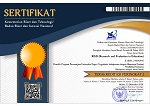Developing a model of soft-skill teaching for civil engineering students
DOI:
https://doi.org/10.21831/reid.v2i2.8220Keywords:
model development, soft skillsAbstract
References
Barron, B., & Hammond, L. D. (2008). Teaching for meaningful learning: A review of research on inquiry-based and cooperative learning. San Francisco, CA: John Wiley & Sons.
CBI/EDI. (2011). Education and skills survey. London: New Oxford.
Cicchetti, D., Bronen, R., Spencer, S., Haut, S., Berg, A., Oliver, P., & Tyrer, P. (2006). Rating scales, scales of measurement, issues of reliability resolving some critical issues for clinicians and researchers. The Journal of Nervous and Mental Disease, 194, 557-564.
Dick, W., Carey, L., & Carey, J.O. (2009). The systematic design of instruction (7th ed.). Boston, MA: Pearson Education.
Guskey, T.R, & Bailey, J.M. (2001). Developing grading and reporting systems for student learning. California, CA: Corwin Press.
Hager, P. & Holland, S. (Eds.). (2006). Graduate attributes learning and employability. Dordrectht: Springer.
Joyce, B. & Weil, M. (2003). Models of teaching. New Delhi: Prentice-Hall
Landis, J.R. & Koch, G.G. (1977). The measurement of observer agreement for categoricl data. Biometric, 33, 159-174.
NACOL. (2008). Virtual schools and 21st century skills. Retrieved on 17 November 2010, from http://www.p21.org/storage/-documents/VSand21stCenturySkillsFINALPaper.pdf
Newton, B., Hurstfield, J., Miller, L., Page, R., & Akroyd, K. (2005). What employers look for when recruiting the unemployed and inactive: Skills, characteristics and qualifi-cations. Leeds: Corporate Document Services
Nieveen, N. (1999). Prototyping to reach product quality. In T. Plomp, N. Nieveen, K. Gustafson, R. Branch, & J. van den Akker (eds.), Design approaches and tools in education and training (pp. 125-136). London: Kluwer Academic.
Musthan, Z., Suhartono, S., Tirtaraharja, U., & Rahamma, T. (2013) On ict-based learning model of islamic education at senior high school 4 Kendari South-East Sulawesi Province. Journal of Arts, Science & Commerce, IV, 32-4.
Parakandi, M.R. (2011). People skills. Retrieved on 26 July 2012 from shodhganga.-inflibnet.ac.in/.../07_chapter%20.
Richey, R.C. & Klein, J.D. (2007). Design and development research. New York, NY: Routledge.
Sharan, S. (1980). Cooperative learning in small group: Recent methods and effect on achievement, attitudes and ethnics relation. Review of Educational Research, 50, 241-271.
Downloads
Published
How to Cite
Issue
Section
Citation Check
License
The authors submitting a manuscript to this journal agree that, if accepted for publication, copyright publishing of the submission shall be assigned to REID (Research and Evaluation in Education). However, even though the journal asks for a copyright transfer, the authors retain (or are granted back) significant scholarly rights.
The copyright transfer agreement form can be downloaded here: [REID Copyright Transfer Agreement Form]
The copyright form should be signed originally and sent to the Editorial Office through email to reid.ppsuny@uny.ac.id

REID (Research and Evaluation in Education) by http://journal.uny.ac.id/index.php/reid is licensed under a Creative Commons Attribution-ShareAlike 4.0 International License.







.png)





